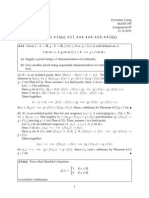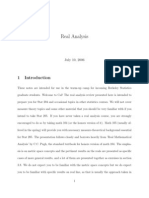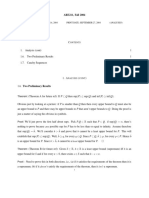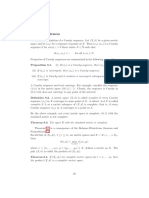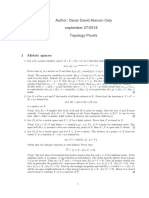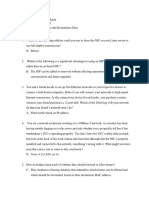Metric Spaces: 4.1 Completeness
Uploaded by
Juan Carlos Sanchez FloresMetric Spaces: 4.1 Completeness
Uploaded by
Juan Carlos Sanchez FloresChapter 4
Metric Spaces
4.1 Completeness
Denition 4.1.1 Let (x
n
) be a sequence in (X, d). Then (x
n
) is called a Cauchy
sequence if > 0 N s.t. n, m > N d(x
n
, x
m
) < .
Proposition 4.1.2 (x
n
) x (x
n
) Cauchy.
Proof: Obvious.
Denition 4.1.3 A complete metric space is one in which Cauchy sequences (x
n
)
x X s.t. (x
n
) x.
Denition 4.1.4 A complete normed vector space is called a Banach space.
Proposition 4.1.5 Suppose (X, d) is complete, and Y X. Then Y is complete
Y is closed.
Proof: Exercise.
Theorem 4.1.6 Cantor intersection theorem Let (X, d) be a complete metric
space. Let (F
n
) be a decreasing sequence of nonempty closed subsets of X s.t. diam(F
n
)
0 in R. Then
n
F
n
contains exactly one point.
Proof: Let F =
n
F
n
. If F contains two points x and y then we have a contradiction
when diam(F
n
) < d(x, y). Hence |F| 1.
n choose x
n
F
n
. diam(F
n
) 0 (x
n
) is Cauchy.
Hence x X s.t. (x
n
) x. We show that x F
n
n. If {x
n
} is nite then
x
n
= x for innitely many n, so that x F
n
for innitely many n. Since F
n+1
F
n
this implies x F
n
n. So suppose {x
n
} is innite. m, (x
m
, x
m+1
, . . . , x
m+k
, . . . ) is
a sequence in F
m
converging to x. Since {x
n
}
nm
is innite, this implies x is a limit
point of F
m
. But F
m
is closed, so x F
m
. 2
32
Theorem 4.1.7 Let (X, d) be a metric space. Then ! metric space (
X,
d) together
with an isometry : X
X s.t.
1. (
X,
d) is complete.
2. Given any complete (Y, d
) and an isometry j : X Y , ! isometry
j:
X Y
s.t.
Note: An isometry f : X Y is a map s.t. d
_
f(a), f(b)
_
= d(a, b) a, b X.
Denition 4.1.8
X is called the completion of X.
Sketch of Proof:
Let C = { Cauchy sequences in X}.
Impose an equivalence relation (x
n
) (y
n
) if d(x
n
, y
n
) 0 in R.
Let
X = C/ . Dene
d
_
(x
n
), (y
n
)
_
= lim
n
d(x
n
, y
n
).
Dene : X
X by x (x, x, . . . , x, . . .) Check that it works. (Exercise) 2
Proposition 4.1.9 X is dense in
X.
Proof:
X is closed in
X, so complete. It also satises the universal property of
completion so
X =
X. 2
Denition 4.1.10 f : X Y is called uniformly continuous if > 0, > 0 s.t.
d(a, b) < d
_
f(a), f(b)
_
< .
Proposition 4.1.11 f : X Y is uniformly continuous, (x
n
) is Cauchy in X
_
f(x
n
)
_
is Cauchy in Y .
Proof: Exercise.
Denition 4.1.12 Let (f
n
) be a sequence of functions f
n
: X Y . We say f
n
converges uniformly to f : X Y if > 0 N s.t. n > N d
_
f(x), f(y)
_
<
x X.
Proposition 4.1.13 Suppose f
n
converges uniformly to f and f
n
is continuous n.
Then f is continuous.
Proof: Let a X. Show f is continuous at a. Given > 0, choose N
0
s.t. n N
0
d
_
f(x), f
n
(x)
_
< /3 x X.
Choose s.t. d(x, a) < d
_
f
N
0
(x), f
N
0
(a)
_
< /3. Then d(x, a) <
d
_
f(x), f(a)
_
d
_
f(x), f
N
0
(x)
_
+d
_
f
N
0
(x), f
N
0
(a)
_
+d
_
f
N
0
(a), f(a)
_
< /3+/3+/3
= . 2
33
Example 4.1.14 Sequence of continuous functions whose pointwise limit is not con-
tinuous:
f
n
: [0, 1] [0, 1], f
n
(x) = x
n
. f(x) =
_
0 x < 1;
1 x = 1.
Notation: Let X be a topological space (not necessarily metric).
C(X, R), resp. C(X, C) are real-valued (resp. complex-valued) bounded continuous
functions on X.
Proposition 4.1.15 C(X, R) and C(X, C) are Banach spaces.
Proof: Let Y = C(X, R), or C(X, C).
For f Y , setting ||f|| = sup
xX
|f(x)| makes Y into a normed vector space. Let
(f
n
) be a Cauchy sequence in Y . Then x X,
_
f
n
(x)
_
is a Cauchy sequence in R
(resp. C) so set f(x) = lim
n
f
n
(x).
Must show f is bounded and continuous, and show (f
n
) f in Y .
Given > 0, nd N s.t. n, m > N ||f
n
f
m
|| < /2.
Given x X nd n
x
> N s.t. |f
nx
(x) f
n
(x)| < /2.
Then n > N |f(x) f
n
(x)| |f(x) f
nx
(x)| +|f
nx
(x) f
n
(x)| < /2 +/2 =
Hence (f
n
) converges uniformly to f so f is continuous. ||f|| ||f f
N
|| + ||f
N
||
< ||f
N
|| + < so f is bounded. Therefore f Y , and {f} f in Y since
||f f
N
|| 0.
Theorem 4.1.16 [Tietzes extension theorem]
Let X be normal and A X is closed. Let f : A [p, q]. Then there exists
F : X [p, q] s.t. F|
A
= f.
Proof: If p = q then f is constant and the theorem is trivial so suppose p < q. Let
c = max(p, q).
Claim: h : X [c/3, c/3] s.t. |h(a) f(a)| 2/3c a A.
Proof: Set A
= f
1
[c, c/3] and A
+
= f
1
[c/3, c]. By Urysohn, g : X [0, 1]
s.t. g(A
) = 0 and g(A
+
) = 1.
Composing with a homeomorphism of [0, 1] with [c/3, c/3] gives a function h :
X [c/3, c/3] s.t. h(A
) = c/3 and h(A
+
) = c/3. If a A then |h(a) f(a)|
2/3c.
Apply the Claim to f. This implies h
1
: X [c/3, c/3] s.t. |f(a) h
1
(a)|
2/3c. Apply the Claim to f h
1
. This implies h
2
: X [2c/3
2
, 2c/3
2
] s.t. |f(a)
h
1
(a)h
2
(a)| (2/3)
2
c. By induction, we apply the Claim to f h
1
h
n1
. This
implies h
n
: X [2
n1
c/3
n
, 2
n
c/3
n
] s.t. |f(a) h
1
(a) h
n1
(a)| (2/3)
n
c.
Let G(x) =
n=1
h
n
(x).
x X,
|G(x)|
n=1
| |h
n
(x)| |
n=1
| |h
n
| | = c/3(1+2/3+(2/3)
2
+. . . ) = c/3(
1
1 2/3
) = c.
34
The partial sums of G are a Cauchy sequence in C(X, R).
Hence by completeness of C(X, R) their pointwise limit G : X [c, c] is contin-
uous.
Dene F by
F(x) =
_
_
G(x) if p G(x)
p ifG(x) < p
q ifG(x) > q
F|
A
= G|
A
since p f(a) q a A. 2
4.1.1 Compactness in Metric Spaces
Proposition 4.1.17 A sequentially compact metric space is complete.
Proof: Suppose X is sequentially compact, and (x
n
) is Cauchy in X.
Some convergent subsequence of (x
n
) converges to x X so since (x
n
) is Cauchy,
with (x
n
) x. That is, given > 0, N s.t. m, n N d(x
n
, x
m
) < /2. Therefore
since some subsequence of (x
n
) converges, N
/2
(x) contains x
m
for innitely many m,
so m > N s.t. x
m
N
/2
(x) and therefore n N d(x
n
, x) d(x
n
, x
m
) +
d(x
m
, x) < /2 + /2 = .
Denition 4.1.18 Given > 0, a nite subset T of X is called an -net if {N
(t)}
tT
forms an open cover of X.
X is called totally bounded if > 0, an -net for X.
Note: X totally bounded diam(X) < diam(T) + 2 and diam(T) < since T
nite, so totally bounded implies bounded.
Example 4.1.19 Suppose X is innite with
d(x, y) =
_
0 x = y
1 x = y
Then X is bounded but an -net for any < 1.
Theorem 4.1.20 For metric X, the following are equivalent:
1. X compact
2. X sequentially compact
3. X is complete and totally bounded.
35
Proof:
(1) (2)
Already showed: metric rst countable and Hausdor
and rst countable and Hausdor and compact sequentially compact.
(2) (3):
Suppose X is sequentially compact.
We already showed this implies X is complete.
Given > 0: Pick a
1
X.
Having chosen a
1
, . . . , a
n1
if N
(a
1
) . . . N
(a
n1
) covers X, we are nished.
If not, choose a
n
X
_
N
(a
1
) . . . N
(a
n1
)
_
.
So either we get an -net {a
1
, . . . , a
n
} for some n, or we get an innite sequence
(a
1
, a
2
, . . . , a
n
, . . . ).
If the latter: By construction d(a
k
, a
n
) k, n so (a
n
) has no convergent subse-
quence. This is a contradiction. So the former holds. 2
(2) (1):
Denition 4.1.21 Let {G
}
J
be an open cover of the metric space X. Then a > 0
is called a Lebesgue number for the cover if diam(A) < a A G
for some .
Theorem 4.1.22 Lebesgues Covering Lemma If X is sequentially compact, then
every open cover has a Lebesgue number.
Proof: Let {U
}
J
be an open cover.
Say A X is big if A is not contained in any U
.
If big subsets then any a > 0 is a Lebesgue number, so assume big subsets.
Let a = inf{diam(A) | A big}
If a > 0, a is a Lebesgue number, so we assume a = 0 .
Hence n > 0, a big B
n
s.t. diam(B
n
) < 1/n.
n, pick x
n
B
n
. Find x s.t. a subsequence of (x
n
) converges to x.
Find
0
s.t. x U
0
.
U
0
is open, so r > 0 s.t. N
r
(x) U
0
.
For innitely many n, x
n
N
r/2
(x).
Find N s.t. N > 2/r and x
N
N
r/2
(x).
diam(B
N
) < 1/N < r/2 and B
N
N
r/2
(x) =
_
since x B
N
N
r/2
(x)
_
so
B
N
N
r
(x) U
0
. This is a contradiction, since B
N
is big.
Hence a > 0 so X has a Lebesgue number.
Proof that (2) (1):
Given an open cover {U
}
J
, nd a Lebesgue number a for {U
}.
Let = a/3 and using (2) (3) from the above, pick an -net T = {t
1
, t
2
, . . . , t
n
}.
For k = 1, . . . , n diamN
(t
k
) = 2 < a so N
(t
k
) U
k
for some
4
.
Since {N
(t
1
), N
(t
2
), . . . , N
(t
n
)} covers X (by denition of -net), so does {U
1
, . . . , U
n
}.
36
3 2:
Suppose X is complete and totally bounded.
Let S
(0)
= (x
1
, x
2
, . . . , x
m
, . . . ) be a sequence in X.
Since X is complete, to show S
(0)
has a convergent subsequence, it suces to show
S
(0)
has a Cauchy subsequence.
Choosing an -net for = 1/2, cover X with nitely many balls of radius 1/2. Since
S
(0)
is innite, some ball contains innitely many x
m
so discard the x
n
outside that
ball to get a subsequence S
(1)
= (x
(1)
1
, x
(1)
2
, . . . , x
(1)
m
, . . . ) with d(x
(1)
m
, x
(1)
p
) < 2 = 1
m, p. Repeating this procedure with = 1/4, 1/6, . . . , 1/(2n), . . . gives for each n a
subsequence of S
(n1)
.
S
(n)
= (x
(n)
1
, x
(n)
2
, . . . , x
(n)
m
, . . . ) s.t. d(x
(n)
m
, x
(n)
p
) < 1/n m, p.
Let S
(n)
= (x
(1)
1
, x
(2)
2
, . . . , x
(n)
n
, . . . )
If m, p n then since S
(m)
and S
(p)
are subsequences of S
(n)
, d(x
(m)
m
, x
(p)
p
) < 1/n
so S is a Cauchy subsequence of S
(0)
as desired. 2
Theorem 4.1.23 If X and Y are metric spaces, and f : X Y is a continuous
function with X compact, then f is uniformly continuous.
Proof: Given > 0, x f
1
_
N
/2
(f(x)
_
, so
_
f
1
_
N
/2
(f(x)
_
_
xX
is an open cover
of X.
Let be a Lebesgue number for this cover.
a, b X: d(a, b) < diam{a, b} < {a, b} f
1
_
N
/2
(f(x)
_
for some x.
Hence d
_
f(a), f(b)
_
d
_
f(a), f(x)
_
+ d
_
f(x), f(b)
_
< /2 + /2 = . Hence f is
uniformly continuous.
2
Corollary 4.1.24 A compact metric space is second countable.
Lemma 4.1.25 For metric spaces second countable separable.
Proof: Second countable separable in general.
= Suppose X is a separable metric space. Let {x
1
, . . . , x
n
, . . . } be a countable
dense subset. Then {N
r
(x
j
)| r rational } forms a countable basis for X. (That is:
Given N
r
(x), nd x
n
s.t. d(x
n
, x) < r
/3. Choose rational r s.t. r < r
/3. Then
N
r
(x
n
) N
r
(x). )
Proof of Corollary: Suppose X is a compact metric space. Show X is separable.
For each = 1/n, choose an -net T
n
= {x
(n)
1
, . . . , x
(n)
kn
}. Let S =
n
T
n
. Then S is
a countable dense subset of X.
2
Example 4.1.26 Normal but not metric:
Let X =
tR
I
t
where I
t
= [0, 1] t. X is compact by Tychono and is Hausdor
so X is normal.
37
If X were metric, then being compact, it would be second countable.
Let S = {U
1
, . . . , U
n
, . . . } will be a countable basis.
Since R is uncountable, t
n
R s.t.
t
0
(U
n
) = I
t
0
n. But then S is not a basis.
(e.g. The set (1/4, 3/4)
t=t
0
I
t
is not a union of sets in S.
This is a contradiction. So X is not metric.
2
38
You might also like
- Solution Manual Elias M - Stein Rami Shakarchi-Real Analysis PDF100% (4)Solution Manual Elias M - Stein Rami Shakarchi-Real Analysis PDF112 pages
- Apostol Solution Ch7 Mathematical Analysis 2e100% (1)Apostol Solution Ch7 Mathematical Analysis 2e51 pages
- Introductory Functional Analysis With ApplicationsNo ratings yetIntroductory Functional Analysis With Applications14 pages
- LinearAlalysis2024 (More Complete Version)No ratings yetLinearAlalysis2024 (More Complete Version)43 pages
- Unctional Analysis: Georg-August University Göttingen Summer Semester 2019 Prof. Dr. Max WardetzkyNo ratings yetUnctional Analysis: Georg-August University Göttingen Summer Semester 2019 Prof. Dr. Max Wardetzky50 pages
- 1 2 X 1 2 X X (,1) X X X (,1) 1 N 1 2 N I 1 X 1 2 1 NNo ratings yet1 2 X 1 2 X X (,1) X X X (,1) 1 N 1 2 N I 1 X 1 2 1 N5 pages
- Chapter 3 Contraction Mapping Prinicple 2024No ratings yetChapter 3 Contraction Mapping Prinicple 202433 pages
- Solutions To Exercises:, Y) ) Is Dense in X y /2 /2No ratings yetSolutions To Exercises:, Y) ) Is Dense in X y /2 /272 pages
- Topology I - Exercises and Solutions: Author: Oscar David Alarcon CelyNo ratings yetTopology I - Exercises and Solutions: Author: Oscar David Alarcon Cely10 pages
- Elgenfunction Expansions Associated with Second Order Differential EquationsFrom EverandElgenfunction Expansions Associated with Second Order Differential EquationsNo ratings yet
- Heating and Cooling With Geothermal EnergyNo ratings yetHeating and Cooling With Geothermal Energy34 pages
- The Boundary Unbounded Fatou Components of Entire FunctionsNo ratings yetThe Boundary Unbounded Fatou Components of Entire Functions15 pages
- Service Manual - LG Monitor - 500E-G - Chassis CA-133100% (1)Service Manual - LG Monitor - 500E-G - Chassis CA-13332 pages
- From Idea To App - Creating IOS UI Animations and Gestures Voices That Matter100% (1)From Idea To App - Creating IOS UI Animations and Gestures Voices That Matter265 pages
- A Biography of Baba Syed Shahabuddin Suherwardi HyderabadNo ratings yetA Biography of Baba Syed Shahabuddin Suherwardi Hyderabad5 pages
- Class Schedule in Esp: Regular Time Slot Time Slot in The New Normal SituationNo ratings yetClass Schedule in Esp: Regular Time Slot Time Slot in The New Normal Situation5 pages
- Nadia Nur Saida - 2111521007 - Tugas Chapter 6 Jaringan Dan Komunikasi DataNo ratings yetNadia Nur Saida - 2111521007 - Tugas Chapter 6 Jaringan Dan Komunikasi Data3 pages
- Elliptic Curves, Modular Forms, and Their L-FunctionsNo ratings yetElliptic Curves, Modular Forms, and Their L-Functions214 pages
- B1 TEST January 2009: Fill in The Gaps With The Correct Word in EnglishNo ratings yetB1 TEST January 2009: Fill in The Gaps With The Correct Word in English2 pages
- Output For: (Authentic Assessment of Student Learning Outcomes) Chapter 1 - 5No ratings yetOutput For: (Authentic Assessment of Student Learning Outcomes) Chapter 1 - 520 pages
- Past Simple Reg Irreg Verbs Grammar Exercises 1c2ba Eso Curso 2013 14No ratings yetPast Simple Reg Irreg Verbs Grammar Exercises 1c2ba Eso Curso 2013 1413 pages
- Evening Prayer (Vespers) in The English Parochial Tradition According To Orthodox Catholic UsageNo ratings yetEvening Prayer (Vespers) in The English Parochial Tradition According To Orthodox Catholic Usage4 pages
- Poetry Analysis.docx_20241127_104057_0000No ratings yetPoetry Analysis.docx_20241127_104057_00003 pages
- Foundation Course Semester I Overview of Indan SocietyNo ratings yetFoundation Course Semester I Overview of Indan Society19 pages
- Real Conditional Sentences With "If" ClausesNo ratings yetReal Conditional Sentences With "If" Clauses2 pages
- How To Configure Electronic Bank Statements in SAPNo ratings yetHow To Configure Electronic Bank Statements in SAP3 pages
- Solution Manual Elias M - Stein Rami Shakarchi-Real Analysis PDFSolution Manual Elias M - Stein Rami Shakarchi-Real Analysis PDF
- Introductory Functional Analysis With ApplicationsIntroductory Functional Analysis With Applications
- Unctional Analysis: Georg-August University Göttingen Summer Semester 2019 Prof. Dr. Max WardetzkyUnctional Analysis: Georg-August University Göttingen Summer Semester 2019 Prof. Dr. Max Wardetzky
- 1 2 X 1 2 X X (,1) X X X (,1) 1 N 1 2 N I 1 X 1 2 1 N1 2 X 1 2 X X (,1) X X X (,1) 1 N 1 2 N I 1 X 1 2 1 N
- Solutions To Exercises:, Y) ) Is Dense in X y /2 /2Solutions To Exercises:, Y) ) Is Dense in X y /2 /2
- Topology I - Exercises and Solutions: Author: Oscar David Alarcon CelyTopology I - Exercises and Solutions: Author: Oscar David Alarcon Cely
- Elgenfunction Expansions Associated with Second Order Differential EquationsFrom EverandElgenfunction Expansions Associated with Second Order Differential Equations
- The Boundary Unbounded Fatou Components of Entire FunctionsThe Boundary Unbounded Fatou Components of Entire Functions
- Service Manual - LG Monitor - 500E-G - Chassis CA-133Service Manual - LG Monitor - 500E-G - Chassis CA-133
- From Idea To App - Creating IOS UI Animations and Gestures Voices That MatterFrom Idea To App - Creating IOS UI Animations and Gestures Voices That Matter
- A Biography of Baba Syed Shahabuddin Suherwardi HyderabadA Biography of Baba Syed Shahabuddin Suherwardi Hyderabad
- Class Schedule in Esp: Regular Time Slot Time Slot in The New Normal SituationClass Schedule in Esp: Regular Time Slot Time Slot in The New Normal Situation
- Nadia Nur Saida - 2111521007 - Tugas Chapter 6 Jaringan Dan Komunikasi DataNadia Nur Saida - 2111521007 - Tugas Chapter 6 Jaringan Dan Komunikasi Data
- Elliptic Curves, Modular Forms, and Their L-FunctionsElliptic Curves, Modular Forms, and Their L-Functions
- B1 TEST January 2009: Fill in The Gaps With The Correct Word in EnglishB1 TEST January 2009: Fill in The Gaps With The Correct Word in English
- Output For: (Authentic Assessment of Student Learning Outcomes) Chapter 1 - 5Output For: (Authentic Assessment of Student Learning Outcomes) Chapter 1 - 5
- Past Simple Reg Irreg Verbs Grammar Exercises 1c2ba Eso Curso 2013 14Past Simple Reg Irreg Verbs Grammar Exercises 1c2ba Eso Curso 2013 14
- Evening Prayer (Vespers) in The English Parochial Tradition According To Orthodox Catholic UsageEvening Prayer (Vespers) in The English Parochial Tradition According To Orthodox Catholic Usage
- Foundation Course Semester I Overview of Indan SocietyFoundation Course Semester I Overview of Indan Society
- How To Configure Electronic Bank Statements in SAPHow To Configure Electronic Bank Statements in SAP




















